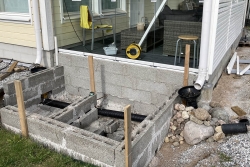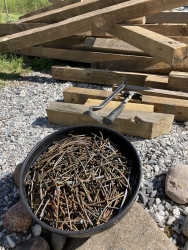OpenSSH 8.3 client fails with: load pubkey invalid format - Part 2
Sunday, September 13. 2020
load pubkey: invalid formatThe original blog post is here.
Now Mr. Stott approached me with a comment. He suggested to check the new OpenSSH file format.
I was like "What?! New what? What new format!".
The obvious next move was to go googling the topic. And yes, indeed there exists two common formats for stored OpenSSH keys. Two pieces of articles I found most helpful were The OpenSSH Private Key Format and Openssh Private Key to RSA Private Key. Reading ssh-keygen man-page states:
-m key_format
Specify a key format for key generation, the -i (import), -e (export) conversion options, and the -p change passphrase operation.
The latter may be used to convert between OpenSSH private key and PEM private key formats.
The supported key formats are: “RFC4716” (RFC 4716/SSH2 public or private key), “PKCS8” (PKCS8 public or private key) or “PEM” (PEM public key).
The commonly used two formats can be identified by first line of the private key. Old format has the header of
-----BEGIN EC PRIVATE KEY-----. Obviously, those who are using RSA or Ed25519 keys, the word "EC" would be different. I've been using ECDSA for a while and am considering moving forward with Ed25519 when all of my clients and servers have proper support for it.
I've always "loved" (to hate) SSH's (non-)intuitive user experience. As suggested by all source, to convert my existing key to new PEM-format all I need is to whip up a key generator and use it to change the passphrase. Yeah. ![]()
As my OpenSSH-client is OpenSSH_8.3p1 31 Mar 2020, its ssh-keygen will default to output keys in the new format. Depending on your version, the defaults might vary. Anyway, if you're on a really old version, you won't be having the mentioned problem in the first place.
Warning: Changing private key passphrase will execute an in-place replace of the file. If you'll be needing the files in old format, best backup them first. Also, you can convert the format back if you want. It won't produce an exact copy of the original file, but it will be in old format.
For those not using passphrases in their private files: you can always enter the same passphrase (nothing) to re-format the files. The operation doesn't require the keys to have any.
Example conversion:
$ ssh-keygen -p -f my-precious-SSH-key
Enter old passphrase:
Enter new passphrase (empty for no passphrase):
Enter same passphrase again:
Your identification has been saved with the new passphrase.
Now the first line of the private key stands at:
-----BEGIN OPENSSH PRIVATE KEY-----
Notice how the key type has been changed into "OPENSSH". The key is still an ECDSA-key, but has been stored in a different.
Testing with the new key indicates a success. Now more warnings, but connectivity is still there. After the conversion, my curves are still elliptic in the right places for the server to grant access! Nice.
Summer pasttime - construction
Tuesday, September 8. 2020
Every summer I tend to do some construction work. By construction, I don't mean writing software or fiddling around with computers. By this I actually mean the act of building something from timber and bricks by attaching stuff together with screws and nails to form something new. Any person who owns property knows there is always something needing fixing, facelift or demolition. Also, anybody who has taken such a venture will also know how you can sink your time and money while at it. In case you didn't get the hint: what I'm trying to do here is explain my absence of blogging.
This year, I tore down the back terrace and re-built it. While at it (btw. its not completed yet), I found number of analogies with software engineering. Initially I had a perfectly good back terrace which (almost) served its purpose. It wasn't perfectly architected nor implemented, it was kinda thrown together like your basic PHP-website. It kinda worked, but there were a few kinks here and there. And to be absolutely clear: I didn't architect nor implement the original one. I just happened to be there, use it and eventually alter the original spec.
On moving in, I ordered really nice glassing to the terrace. Everything worked fine for many years and I was happy. This same thing happens with your really cheap hosting provider, years pass by and eventually it will the hit the fan. When it happens, you're left alone without any kind of support wondering what happened and how you're going to fix the site. I found out that by adding the terrace glassing, I had altered the requirements. Now there existed an implicit requirement for the terrace to stay level, as in not move. At all. Any minuscule movement will be ... well ... not good for your glassing making the glasses not slide in their assigned rails as well as originally intended. Exactly like your cheap website, I had no idea how the entire thing was architected. And any new requirements would de-rail the implementation (in this case: literally) making reality hit me into forehead (in this case: literally). During those years of successful living the terrace had moved and sunk a bit into soft sand. Not much, but enough for the glassings to mis-fit.
Upon realizing this, there was no real alternative. Old design had to go and new one needed to be made. Like in a software project, I begun by investigating what was implemented. In construction you would read this as: removing already constructed materials enough to be able to determine how the terrace was founded and how it was put together. In software engineering investigation is always easier and less intrusive leaving no gaping holes to structure. In this project I simply took a crowbar and let it rip. Also, during re-thinking period I came up with completely new requirements. Obviously I didn't want the thing to be sinking nor moving, I also wanted to have the bottom rails of the glassing on top of something hard instead of wood. Any organic material, like wood, has the tendency to twist, warp, shrink, expand and rot. When talking about millimeter accuracy of a glassing, that's not an optimal attribute in a construction material. Experience has shown, that when wood does all of the mentioned things, it does it in the wrong way making your life miserable. So, no more wood. More bricks.
This is what it nearly looked like in the beginning and how it looks like now (I'm skipping the in-between pics simply because they're boring):

Now everything is back and my new spec has been implemented. During the process of demolition, I yanked out couple of kilos of rusty nails:

Personally, I don't use much nails, not even with a nail gun. My prefenrece, when it makes sense, is always to attach everything with a screw and I think equal amount of screws have been put into appropriate places to hold the thing tightly together.
Moving foward, I obviously want to complete the new terrace extension. Also, I'd love to get back to computer. Blogging, Snowrunner and such.

